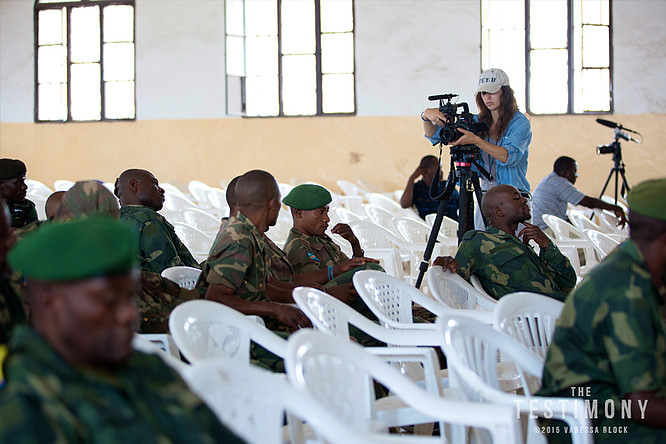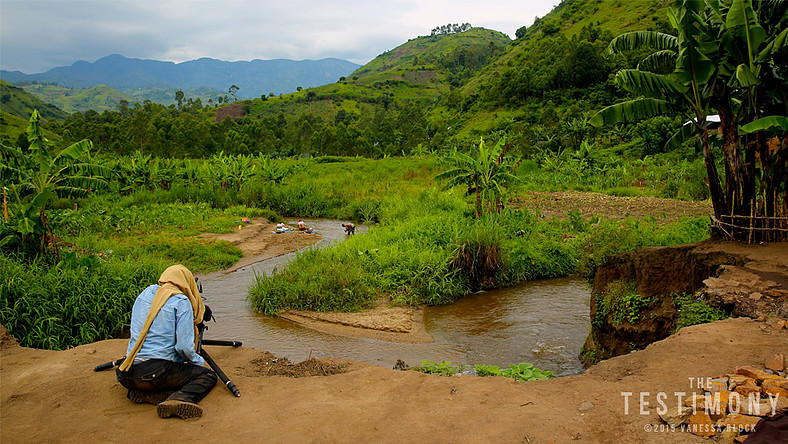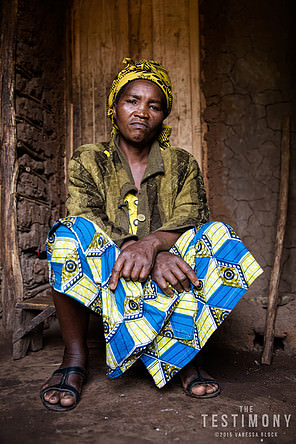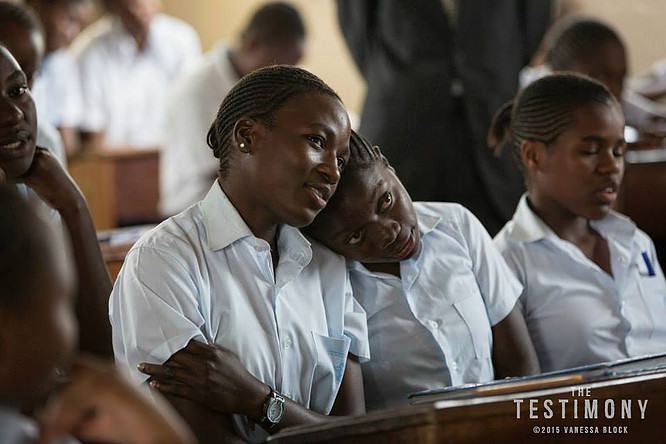Director Vanessa Block & Producer Steve Tisch Discuss Their Oscar Shortlisted Doc The Testimony
"The conflict in the Democratic Republic of the Congo has cost more lives than any other since World War II." This startling fact is one of the first things you learn in director Vanessa Block's documentary short The Testimony, and it lingers in your mind long after the film is finished. What's more astonishing than this brutal metric is the unquestionable strength of the women who live in Congo, specifically Eastern Congo, where there has been a recent spate of horrific violence that's even remarkable for a country with such a tragic history. In November of 2012, M23 rebels drove the Congolese Army out of the Eastern city of Goma, initiating a terrifying spree of rape and murder by the demoralized soldiers. They retreated to Minova, where they raped hundreds of their own civilians. Block's film chronicles the largest rape trial in Congo's history, offering the viewer an unprecedented look into the lives of its embattled, impossibly strong women. We talk to Block and her producer, Steve Tisch, about how this Oscar short-listed documentary came into being.
How did this journey begin for you?
While I was an undergraduate at Yale I met a woman who was Congolese. As I moved into my own education about what was happening in Congo, and Eastern Congo specifically, and I was struck by the gap between the visibility of what was being represented in the media and what was happening on the ground. There have been more deaths since any conflict since World War II, and millions of women have been raped—it’s the epicenter of violence against women globally, and I gained the tools I needed to make a more informed, responsible film. With Steve’s support, I was able to see it through to fruition.

The fact that you were there for the trial was incredible—did you plan that?
The trial was this amazing fortuitious moment, where I didn’t know it was gsoing to happen until I arrived in the country. I went through all the various hurdles you go through when you’re going to shoot something like this.
Has this Congolese woman who had such a big impact on you seen the film?
No! I completely lost touch with her, and haven’t seen her in years. It would be interesting if I could track her down.
What was it like filming in Congo?
You try to get everything as set as one can before you film in Congo. Many of those details I had to forgo having control ahead of time over, however. There were things you could only do in-counry. I intiitally did a Kickstarter campaign, with a short sizzle reel, but obviously I had no footage because I hadn’t been in country yet, so my editor did amazing animation, then that got Steve’s attention who came in and funded the project.
Once in country, there’s no infrastructure at all, it's a war-torn country, so there were a lot of cultural hurdles to overcome. And also the history of the Westerner being in Congo and fracturing this country runs deep. Then there was the emotional challenges of getting the victims to speak to me. Then there were the safety challenges of facing armed militias at every turn, rebels in the jungle, environmental issues, harsh conditions, disease—nothing was easy, but it was very rewarding.

Where were you based during the shoot? What was an average day of shooting like?
There was only so much pre-planning I could do, so I was based in the city of Goma, which has gained a lot of media attention lately because of that huge M23 rebellioin. What happened was this fringe rebel group broke off from the military and successfully pushed the Congolese army from Goma, so there was tremendous unrest, and the soldiers felt totally demoralized, so as a result, they went on a horrific raping and rampaging campaign in Minova, which led to outrage and this trial you see in the film. So I based myself in Goma and from there I traveled into villages, sometimes as far as a few hours away, by truck, and once there we often had to hike for miles and miles. One of the interviews with the little girl talking about the work women had to do, she was in this mountain village that took six hours to hike up to after driving six hours to get there. There were some days where I was sleeping in the truck. Other days, like when were in the park shooting the sunrise and sunset, we slept in these little, well, they call them hotels but they’re really nothing more than these mud floored shitty rooms (laughs), it sort of varied depending upon which area I went to. It definitely was a physical challenge the whole way.
Of the many challenges you faced, I imagine getting these women to open up to you about these tragic, life changing events must have been really hard. The things that happened to them, to their daughters—it's hard to imagine how anyone could survive that.
In terms of the specific interviews, it was incredibly challenging. I found myself focusing as much as I could on hearing the stories, asking the questions, but trying to not allow myself into what those stories represented to them, because that was the only way I could maintain objectivity. To allow myself not to fall apart in these settings, for safety reasons alone that would have been disastrous for me and my whole team. I could connect these women, as a women, on what they went through, but also keeping a little of that edge. My background is in the sciences, I had a lot of experience working in hospitals, and seeing that same process play out, that need for empathy but also the need to maintain the objectivity to do your job.

How do you strike that balance?
It's difficult. The probably single biggest challenge was vacillating between maintaining strength for the sake of my team, but also projecting an air of humility and gentility and softeness, which is such a part of the process of making someone feel comfortable with you and willing to open up to you. Also, you don't want to be seen as naive or easily taken advantage of, that was a constant threat, too.
How did you take care of yourself and your team?
You have to have ten eyeballs going at once while you’re in a place like Eastern Congo; the threats are enormous and they’re constant. There’s always something waiting to go wrong there and 99% of the time it does, at the most inopportune moment, too. I needed to be sharp and aware constantly, so I had to have my attention split while being utterly present for the interviews. One time I became a little bit too engrossed, and a kid came up and stole a lenscap, so we had to go chase him down. I was recording sound, conducting the interview, choosing the subject, filming the interview.
How big was your crew?
It was just me, a still photographer with me who was taking all stills exclusively for promotional material, a translator who was also a fixer, and a driver. Two American girls and two Congolese guys, going around. Because it was a smaller group, it was a little easier to fit in.
How long was the shoot?
Just under two months. It was enough time for me to come back looking a little like Iron Man. I got into the best shape of my life, doing all of that lifting, the anxiety of the trip, you’re constantly moving.

How much did these brutal stories seep into you? It couldn't have been easy to leave and go back to your normal life. Do you feel any hope after having made this film?
We’ll isolate the conversation to eastern Congo; I think it has tremendous potential for growth and change in every respect, from their ability to build infrastructure to their great mineral wealth. But they have their patriarchial society—and it’s going to take tremendous work internally to change that. I was very reluctant to align the film with any NGO or charity, because more often than not it does more damage. I was able to learn through my masters program how damanging some of these NGOs have been to local populations, which was also echoed by the Congolese in my time there. They were vocal about having adversarial relationships with charities. These problems aren’t isolated to the Congo, it’s what we Westerners are bringing to the region, and it starts with colonialism which destroyed the Congo to begin with. My hope with the film is it’s going to start a conversation, it’s a film I made about Congo, for Congo, and I think we need to mirror that to fix the problem.
Steve, tell me about how your involvement in the film.
Steve: Vanessa’s sister Jenna is an executive at my production company, Escape Artists, the company’s based at Sony. Jenna asked if I’d meet with Vanessa, and she said Vanessa had an idea she’d like to discuss with me about a short film. So in the conversations I was having with Vanessa, clearly her passion and her commitment and her vision for the film struck me, and I really felt the importance of the story that Vanessa wanted to tell. I also instinctively knew that she was going to be able to tell this story in a very important way. Obviously this is her first film, so a lot of what I was feeling was blind faith. But after really understanding her vision and how important this story was for her, and how it really needed to be told, I was very supportive of getting behind the project financially and making sure she had the appropriate assets to go over there and put this story and tell this story. I didn’t have to go any further east than Fairfax.
Did you speak with Vanessa while she was in Congo?
There wasn’t very frequent communication. Once Vanessa went over to Congo, there was not a lot of communication because the nature of where she was filming, just not a lot of opportunity to speak on a daily basis, or even on a weekly basis. Vanessa’s parents were very stressed during the time she was there. I just had this real belief that while Vanessa was there, she was going to do exactly what she told me she was going over there to accomplish. When she came back with hundreds of hours of film shot, I got a real sense of how successful she was. When I saw the first rough cut, clearly the movie was addressing so many issues, not just the central issue, it’s a story that’s told on so many levels and so many different opportunities to understand the topicality of the issue of rape against the backround of the trial, but also the women they’re facing and the challenges.
Vanessa, do you have a takeaway from your time in Congo and making this film?
What yo usee there is women doing everything. It didn’t require culling through hundreds of hours of footage, visually, it’s so clear the women are walking around carrying the goods, you see that the men are sitting on their doorstep smoking, you never see men carrying anything in the Congo. It's the women carrying the babies on their back, their loads, it’s so striking and polarizing. It’s so out in the open. It’s a problem we’ve seen such a minimal shift in, but I think fortunately, and I’ll preface this by saying it’s not exclusive from this, but the religious side of things there is not really pushing the patriarchial way, which is a good thing. It's very hard to change people’s mind religiously, so most of these customs are being bequeathed through the genartions rather than through religious texts, so I think over time, and perhaps through gender classes, there are things that can be done to promote movement towards equality. We’re seeing more women being involved in government, and the more women see there’s opportunity outside of domestic life, there’s more chance for a shift. The future of the Congolese woman has to be education, that’s the only way to move out of this lifestyle. That’s the key to female empowerment on a global scale.



